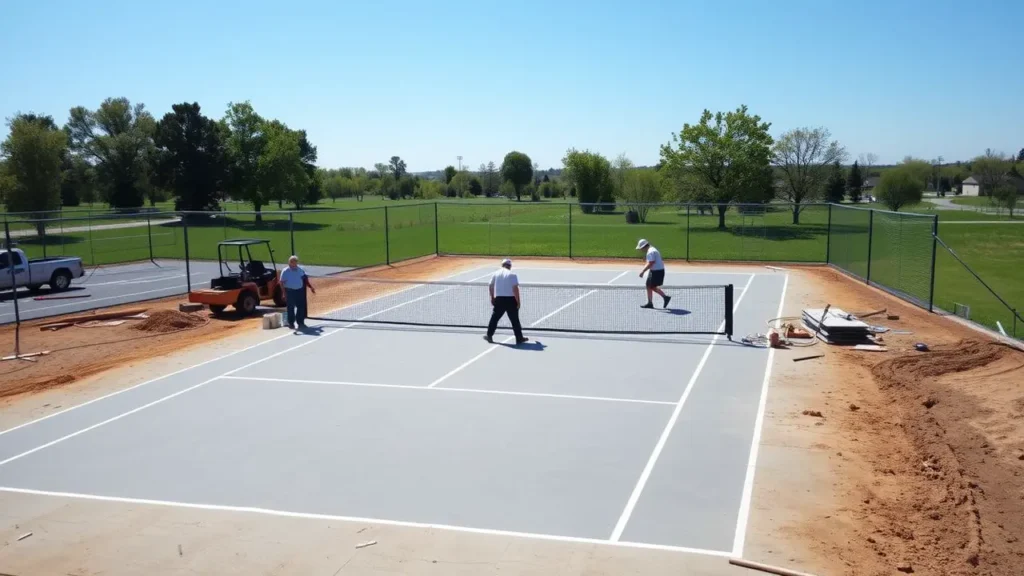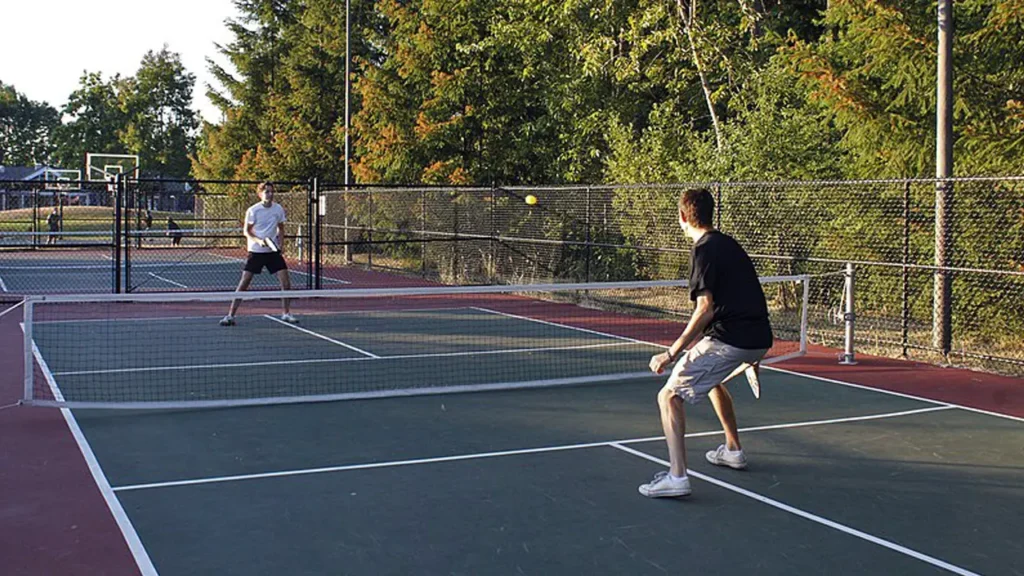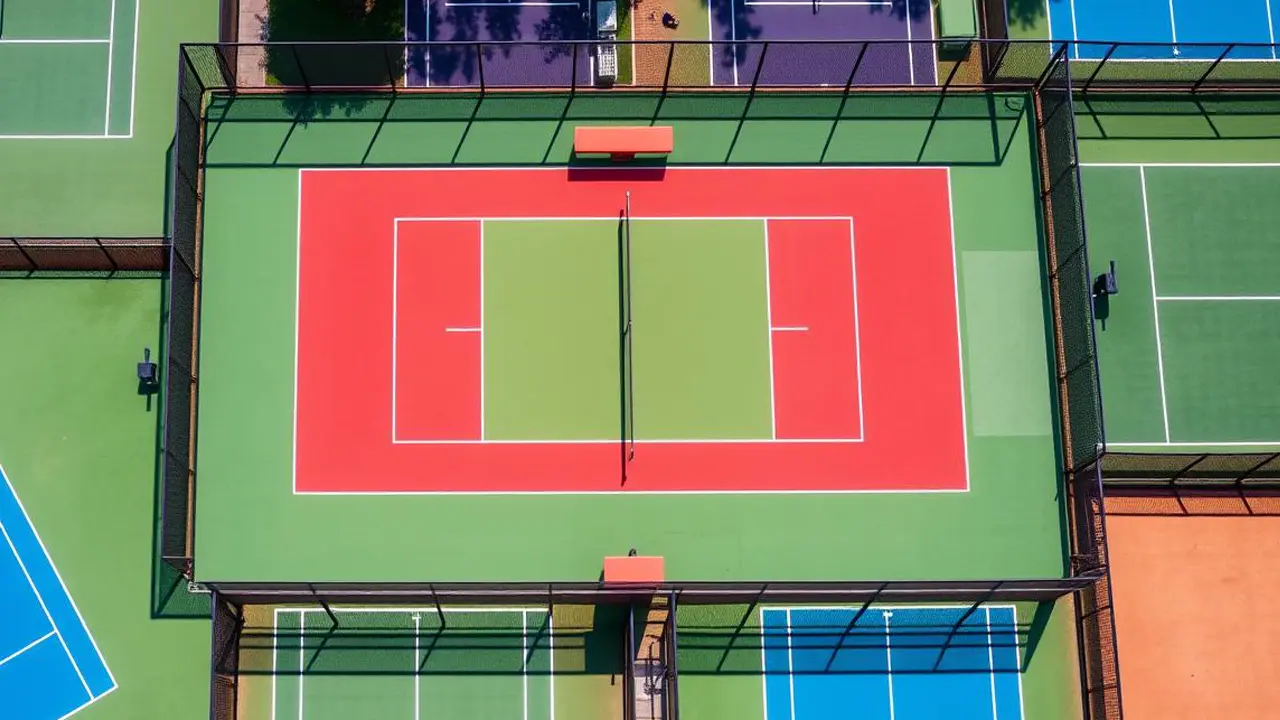Did you know over 36.5 million people play pickleball in the United States? This sport mixes tennis, badminton, and ping-pong. It’s growing fast and attracting many fans. Knowing the court’s size and rules is key for a good game.
A standard pickleball court is 44 feet long and 20 feet wide. The net is 36 inches tall at the sides and 34 inches in the middle. There’s also a 7-foot area called “the kitchen” where players can’t volley. These details help make the game fair and fun for everyone.
Important Points
- A regulation pickleball court is 44 feet long and 20 feet wide.
- The net height is 36 inches at the sidelines and 34 inches at the center.
- The court includes a 7-foot non-volley zone, known as “the kitchen.”
- Pickleball courts can be played on various surfaces, including concrete, asphalt, clay, and grass.
- Pickleball courts are slightly smaller than tennis courts, making the sport more accessible for players of all ages and skill levels.
Introduction to Pickleball
Pickleball is a fun and fast-paced sport that’s becoming very popular. It combines tennis, badminton, and ping-pong in a unique way. This makes it great for people of all ages and skill levels.
The game is played on a smaller court with a special ball and paddles. It requires quick thinking and teamwork. Plus, it’s a great way to meet new people.
Brief Overview of the Sport
Pickleball is played on a 20×44 feet court, which is smaller than a tennis court. Players use light paddles to hit a ball with holes, called a pickleball. The net is 34 inches high, making the game fast and exciting.
It can be played as singles or doubles, making it fun for everyone. Whether you’re young or old, you can enjoy pickleball.
Pickleball’s Rising Popularity
- Pickleball is the fastest-growing sport in the United States for adults.
- Its easy-to-play nature, social aspect, and fun exercise make it very popular.
- It’s especially loved by seniors and is being added to schools for physical education.
- Cities are turning tennis courts into pickleball courts to keep up with demand.
Pickleball has won the hearts of many players and fans. It’s a great way for people of all ages to stay active and have fun. As it grows, it promises to bring more excitement and inclusivity to the sport.
Dimensions of a Regulation Pickleball Court
Pickleball is a fast-growing sport that needs a specific court size for fair play. A regulation court is 44 feet long and 20 feet wide, including lines. This size makes it easy to fit into many sports facilities, welcoming players of all ages and skills.
Net Height and Non-Volley Zone
The net is 36 inches high at the sides and 34 inches in the middle. This creates a challenge for players. The court also has a 7-foot non-volley zone, or “kitchen,” near the net. This zone makes players think about strategy and finesse, making the game exciting and dynamic.
| Pickleball Court Dimensions | Measurement |
|---|---|
| Length | 44 feet |
| Width | 20 feet |
| Net Height at Sidelines | 36 inches |
| Net Height at Center | 34 inches |
| Non-Volley Zone (Kitchen) | 7 feet |
These rules and features make playing pickleball a great experience. They allow players to enjoy the game’s mix of strategy, agility, and friendship.
pickleball
Pickleball is a fast-growing sport with a unique court design. It has a 7-foot non-volley zone, known as the “kitchen.” This area, near the net, stops players from volleying the ball. It makes the game more strategic and exciting.
The smaller dimensions of the court, 44 feet long by 20 feet wide, add to the game’s speed. The smaller size lets players move around more, leading to longer rallies. This makes the game more engaging for everyone.
| Pickleball Court Feature | Description |
|---|---|
| Non-Volley Zone (“Kitchen”) | A 7-foot area extending from the net where players are not allowed to volley the ball |
| Court Dimensions | 44 feet long by 20 feet wide, smaller than a tennis court |
The pickleball court features, like the pickleball non-volley zone and the pickleball kitchen, make the sport popular. They set it apart from other court games.
Comparing Pickleball Court to Other Sports Courts
Pickleball courts are smaller than tennis courts but bigger than badminton courts. A standard pickleball court is 20 feet wide and 44 feet long. Tennis courts, on the other hand, are 60 feet wide and 120 feet long, including alleys for doubles.
The smaller size of pickleball courts means more courts can fit in the same space as one tennis court. You can even fit up to four pickleball courts where one tennis court is. This makes pickleball very popular and easy to play.
| Sport | Court Width | Court Length | Net Height |
|---|---|---|---|
| Pickleball | 20 feet | 44 feet | 34-36 inches |
| Tennis | 60 feet | 120 feet | 36-42 inches |
| Badminton | 20 feet | 44 feet | 5 feet 1 inch |
Pickleball and badminton courts are similar in size, with pickleball being a bit wider. The use of paddles instead of rackets adds to the unique feel of playing pickleball.
Pickleball courts can easily fit into existing sports facilities. This has helped the sport grow fast. Knowing how pickleball courts compare to others shows how versatile and accessible this game is.
Setting Up a Temporary Pickleball Court
Pickleball is getting more popular, and people want to play it everywhere. Setting up a temporary court is easy. This guide will help you create a court for a community event or in your backyard.
Materials Needed
To set up a temporary pickleball court, you’ll need:
- A portable pickleball net
- Measuring tape
- Chalk or removable tape to mark the court boundaries
Step-by-Step Guide
Here’s how to set up a temporary pickleball court:
- Measure the playing area. The official court is 44 feet long by 20 feet wide. Use the measuring tape to mark the baseline and sidelines.
- Designate the non-volley zone (kitchen). This area is 7 feet from the net and 14 feet by 20 feet. Mark it with chalk or removable tape.
- Define the service areas. The service areas are 15 feet from the non-volley zone to the baseline. They are 15-foot by 10-foot areas (two per side).
- Set up the portable net. Place the net at the center of the court. It should be 36 inches high at the sidelines and 34 inches high at the center.
By following these steps, you’ve set up a temporary pickleball court. It’s ready for players of all skill levels. Make sure to adjust the court dimensions and net height as needed for a safe and fun game.
Permanent Pickleball Court Construction
Pickleball is getting more popular, and many fans want to build their own courts. It’s important to pick the right surface and get professional help for the best play experience.
Choosing the Right Surface
There are many surfaces for pickleball courts. You can choose from concrete, asphalt, or special pickleball materials like plastic tiles. Each has its own benefits, like cost, durability, and how well it plays.
Concrete courts last a long time, while asphalt is cheaper. Special surfaces, like VersaCourt tiles, are good for players with joint issues.
Professional Installation
Building a permanent court needs careful work and following the rules. Pros make sure the court is the right size, has good drainage, and the surface is even. This makes playing fun and safe.
Building a new court can cost between $10,000 and $50,000. This depends on the surface, drainage, and extras like lights and fences. Resurfacing costs less, from $3,500 to $5,000. With the help of experts, you can turn your yard into a top-notch court for your community.

Benefits of Playing on a Regulation-Size Court
Playing on a regulation-size pickleball court has many benefits. It ensures fair play and a fun challenge for all players. The court’s size and net height are perfect for an exciting game.
Proper court size helps players improve their skills and strategies. They can better predict where the ball will go. This makes the game more enjoyable and rewarding.
Regulation courts also make it easier to join tournaments and leagues. This helps more people play and enjoy pickleball. It grows the sport and benefits everyone involved.
Research shows playing on a regulation court is good for your health. It’s more active than walking and more fun. Older players even see better breathing and fewer health issues after playing.
Pickleball also boosts your brain. It requires quick thinking and strategy. Playing on a regulation court enhances these skills, improving your overall well-being.
In summary, playing on a regulation pickleball court offers many benefits. It ensures fair play, promotes health, and improves cognitive skills. Following the established court dimensions is key to enjoying and growing the sport.
Finding Pickleball Courts Near You
Pickleball is getting more popular, making it easier to find a court to play on. Whether you’re experienced or new, there are many ways to find courts near you.
Local Parks and Recreational Facilities
Many places in the US have turned tennis courts into pickleball courts. To find courts near you, check your local parks and recreation websites. They usually have info on pickleball courts, hours, and how to reserve them.
Online Resources and Apps
There are also apps and websites to help you find pickleball spots. The PicklePlay app lets you search for courts, clubs, and events. The USA Pickleball Club Directory lists clubs and organizations, helping you find players and events.
These tools make it easy to find a great place to play pickleball. Whether it’s a park or a club, you can find it quickly.
“Over 40,000 members belonging to USA Pickleball are engaged in updating and maintaining court locations on the Places2Play platform.”
Pickleball is growing fast, offering more places to play. Use these resources to join the pickleball community and play your best game.
Tips for Maintaining a Pickleball Court
Keeping your pickleball court in good shape is key for a great game. Cleaning, maintaining, and taking care of your court can make it last longer. It also keeps it ready for play.
Begin with a cleaning schedule. Sweep the court often to get rid of dirt. Power washing helps stop moss and mildew. Sealants or coatings every few years keep the court looking new.
Read More: The Secret World of Artistic Synchronized Swimming
It’s also important to check the net’s tension and height. Make sure it’s right for the game. For permanent courts, fix cracks and uneven spots to avoid more damage.
- Do monthly checks for any problems.
- Keep a log of all maintenance work.
- Get a pro to check the court’s structure yearly.
By focusing on maintenance, upkeep, and care, your court will stay in great shape. This lets you and your friends enjoy the game more.
| Maintenance Task | Frequency |
|---|---|
| Sweep the court | Daily |
| Wash the court with mild detergent | Monthly |
| Apply sealcoat or resurface the court | Every 2-5 years |
| Inspect the court for cracks or damage | Monthly |
| Adjust net tension and height | Monthly |
| Professional deep cleaning | Annually |
“Properly maintaining your pickleball court is the key to ensuring a safe, consistent, and enjoyable playing experience for years to come.”
How to choose the best pickleball paddles?
You can buy best paddles according to your budget. Click here –> pickleball paddle, before picking up, think about these things:
- Weight: Lighter paddles (7.3 oz or less) are easy to control but give less power. Heavier paddles (over 8 oz) give more power but are harder to move quickly.
- Grip Size: Make sure the grip fits your hand. A smaller grip (4-4.25 inches) is better for control. A bigger grip (4.5+ inches) gives more stability.
- Material: Paddles are made from different materials:
- Wood: Cheapest, but heavy.
- Composite: Good balance between control and power.
- Graphite: Lightweight and powerful, good for experienced players.
- Price: Beginners can start with cheaper paddles. As you improve, you might want to buy better ones.

What are the pickleball rules?
Here are some basic rules of pickleball:
- Court: The game is played on a court similar to a badminton court.
- Serve: The ball must be served underhand and diagonally to the other side.
- Scoring: You only score points when you are serving. The game is usually played to 11 points, and you must win by 2 points.
- Double Bounce Rule: After the serve, the ball must bounce once on each side before players can hit it in the air (volley).
- Non-Volley Zone (Kitchen): You cannot hit the ball in the air while standing in the non-volley zone (the area close to the net).
- Faults: You lose a point if you hit the ball out of bounds, into the net, or if it does not clear the net.
Conclusion
Pickleball’s fast growth and popularity come from its unique court design. Knowing the standard 44-foot length and 20-foot width of a pickleball court helps players see the game’s strategy and challenge.
Setting up a pickleball court right is key for fair play and fun. This is true for both casual and competitive players. As the pickleball community grows, having good courts is crucial for the sport’s future.
Knowing about pickleball court specifications and upkeep lets players enjoy the game fully. With its small pickleball court size, clear pickleball rules, and wide range of pickleball equipment, it welcomes people of all ages and fitness levels.
FAQ
What is pickleball?
Pickleball is a paddle sport that mixes tennis, badminton, and ping-pong. It’s played on a court with a low net. Players use a paddle and a special plastic ball.
What are the dimensions of a regulation pickleball court?
A standard court is 44 feet long and 20 feet wide. The net is 36 inches high at the sides and 34 inches in the middle. There’s also a 7-foot zone, called the “kitchen”, where players can’t volley the ball.
What are the unique features of a pickleball court?
The court’s main feature is the 7-foot “kitchen” zone near the net. Players can’t volley the ball in this area. This rule makes the game strategic and requires skillful shot placement.
How does a pickleball court compare to other sports courts?
Pickleball courts are smaller than tennis courts but bigger than badminton courts. Their size allows for more courts in less space. This makes the game fast-paced and fun.
How do I set up a temporary pickleball court?
To set up a temporary court, you’ll need a portable net, a measuring tape, and chalk or tape. Measure and mark the court’s 44×20 feet and the 7-foot non-volley zone.
What are the considerations for building a permanent pickleball court?
Building a permanent court requires choosing the right surface and following proper construction. Professional installation ensures the court meets regulation standards and provides a smooth playing surface.
What are the benefits of playing on a regulation-size pickleball court?
Playing on a regulation court ensures fair play and helps players develop their skills. It also makes it easier to organize tournaments and leagues in existing sports facilities.
How can I find pickleball courts near me?
Look for local courts on your parks and recreation department’s website or use apps like PicklePlay. These resources list available courts and events.
How do I maintain a pickleball court?
Regular cleaning and maintenance are key. Sweep, power wash, and apply sealants or coatings as needed. Also, check and adjust the net’s tension and height regularly.











